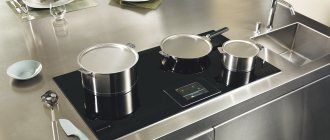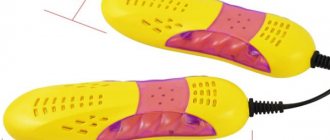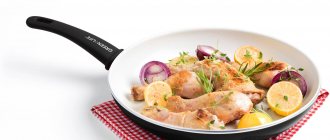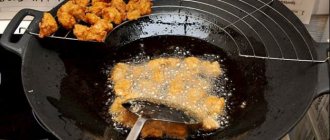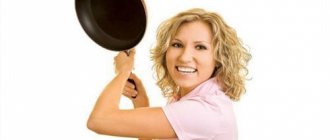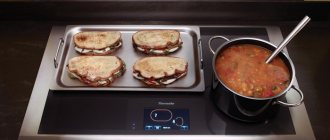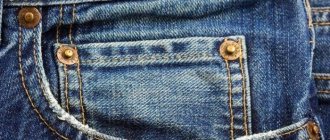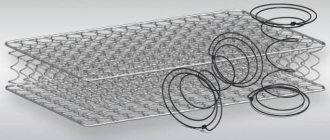The type of hob is one of the main factors that is taken into account when purchasing cookware. How to choose a frying pan for a gas stove and what characteristics should you pay attention to?
Despite the undemanding nature of kitchen stoves powered by gas, you should not think that absolutely any frying pan will do. Study the requirements and features, pay attention to the shape and material, spend a little time on theory, so that in practice the dishes will always turn out well, and the purchase will serve for a long time and will not lose its original appearance.
In this publication:
What to consider when choosing a frying pan for a gas burner
Each manufacturer indicates on the packaging what type of hob the frying pan is intended for. Most of them are suitable for gas stoves. The exception is dishes intended only for electric stoves - these are mainly frying pans with a thin bottom, which are not designed for use at high temperatures.
What should be the correct bottom?
The main difference between a gas stove is the open flame with which the bottom comes into contact during cooking. The intensity of the flame can be changed by adjusting the temperature, but it is better to give preference to pans with a thick bottom. Thin is suitable only for fast-cooking dishes, for example, scrambled eggs, when contact with fire will be short-lived.
The diameter of the pan is an important factor. The diameter must match the burner:
- If it is less than required, the flame will damage the outer enamel of the walls.
- And if it is more, the food around the edges will not be fried.
As a rule, gas stoves are equipped with 4-6 burners, so you need to choose a frying pan based on the volume of the dish and the burner on which you plan to fry.
Especially for gas ovens, grooves , which increase the heating area, creating a higher temperature and speeding up cooking. Another option for a special bottom for a gas burner is a heat-accumulating circle with rays that distribute heat in different directions to the edges of the cookware.
Separately, it is worth highlighting the bottom made of ferrimagnetic alloys - it is in the line for induction hobs. Can this cookware be used on an open flame?
In short, yes, an induction frying pan is suitable for a gas stove and can be used just like any other. For insurance, look for an icon that recommends appropriate use. True, the shiny surface will quickly lose its attractiveness.
Practical outer covering
The outer side of the frying pan can be supplemented with a protective and decorative coating. It happens:
- varnish - it scratches easily and burns quickly, so it is not very suitable for a gas-powered stove;
- enamel - more durable, resistant to high temperatures;
- anti-party - according to the type of internal coating, the strength of the material used and its resistance to fire are important here.
Ideal pen
The handle is an important part; it should be comfortable and not heat up from the body. Handles are molded, removable or attached. The latter are made of metal, bakelite, heat-resistant plastic, and wood.
For gas stoves, it is important that the handle is not afraid of high temperatures. If the material is not fire-resistant, then the handle should not be near the flame during cooking. More practical - metal ones. Especially those made of alloys - these do not heat up from the hot body, they can be handled without tacks.
If the main material is plastic, then at least the part located next to the body must be metal. If there is only one handle, it is better if it is removable so that the pan can fit in the oven. Two molded lugs located on opposite sides are ideal for the oven.
Comfortable handle
Which handle is better and more comfortable, what material to choose?
How convenient it will be to cook depends on the shape and quality of the handle. There is no single rule for choosing - you need to focus on your own feelings. Before purchasing the frying pan, you need to lift it, hold it, and rotate it to make sure that it fits comfortably in your hand.
It is worth paying attention to the type of handle fastening and its reliability. Rivets are not the best option; screws are better. Solid cast products are optimal in this regard. The material of the handle is also worth paying attention to. Good options are treated wood and heat-resistant plastic. Metal handles are the most reliable, but they get very hot. You can choose an option with a removable handle if you plan to cook in the oven often.
Material is one of the selection criteria
Environmental friendliness, lightness, high thermal conductivity and uniform heating, resistance to mechanical damage and deformation - manufacturers have not yet been able to combine all these characteristics in one frying pan. Each material has its pros and cons.
Aluminum frying pans
Aluminum is lightweight, with high thermal conductivity, one of the most popular metals for the production of frying pans. Can be cast or stamped. The first one is thicker and therefore less susceptible to deformation.
To cook meat on a gas stove, the bottom of an aluminum frying pan must be at least 5 mm , for pancakes - 2 mm. To reduce warping, combine aluminum with stainless steel to make pans with multi-layer bottoms, placing a layer of aluminum in the middle.
The popularity of the material is based mainly on its low price. The main disadvantage is porosity, but it is easy to get rid of if you properly prepare an aluminum frying pan for the first use.
Cast iron cookware
Cast iron pans are the best choice for gas stoves. Cast iron distributes heat evenly even with the strongest gas burner flame. Suitable for frying pancakes, fish, vegetables, meat. It is absolutely not afraid of flame, which is why cast iron is often used to make utensils for long-term cooking dishes, such as duck pots and frying pans for tapaka chicken with a heavy press.
One of the main disadvantages of cast iron cookware is weight. This is especially felt with large sizes. In addition, cast iron is susceptible to corrosion , so you need to take care of the natural protective coating that forms after special preparation - oil lubrication and calcination. It is not advisable to use a dishwasher or prolonged soaking for washing.
Stainless steel pans
Steel for the production of kitchen utensils can be carbon or stainless. Carbon is a heat-resistant and durable metal with high thermal conductivity and is not prone to deformation. But it is expensive and susceptible to corrosion without special treatment.
To protect against rust, the carbon steel surface is subjected to oxidation (blueing), and immediately before use it is coated with grease and calcined. But even this preparation does not provide 100% protection, and carbon steel pans are used only for short-term cooking. Do not soak or wash in the dishwasher.
Stainless steel is resistant to electrochemical and atmospheric corrosion and does not emit harmful chemicals. A significant drawback of any steel is low, uneven thermal conductivity , but manufacturers have learned to deal with this too, using the principle of multi-layering. The bottom of such frying pans is made by making a thick bottom layer of aluminum or combining materials - steel-aluminum-steel.
Copper frying utensils
High thermal conductivity and aesthetics are the main advantages of copper cookware. Instant heating can be considered both an advantage and a disadvantage - the rapidly changing temperature of a gas burner requires high skill from the cook.
Copper has antibacterial properties, but it also destroys useful substances - ascorbic acid and vitamins. With prolonged contact, polyunsaturated fatty acids are oxidized, causing serious harm to the body. To prevent contact of copper with food, manufacturers produce copper frying pans tinned on the inside with food-grade tin.
Heat-resistant glass frying pan
You can choose a heat-resistant glass frying pan for a gas stove only if you will be cooking on a flame divider. Direct contact with fire is prohibited. The maximum operating temperature is indicated on the packaging; generally, use at temperatures up to 300 °C is allowed.
A significant drawback of glassware, including tempered glass, is that it is susceptible to sudden changes in temperature . Therefore, do not expose it to temperature shock, do not move it from the refrigerator to the oven, or place it hot on a wet surface.
Top 5. Kukmara Marble Induction
Rating (2021): 4.5
The Russian brand Kukmara offers a whole line of Marble Induction frying pans, suitable for all types of stoves, including induction. The most popular model 260a has a diameter of 26 cm, optimal for most families. The innovative non-stick marble coating is applied by spraying, which guarantees its increased durability. The body of the frying pan is made of cast aluminum, has thickened walls and a 6 mm thick bottom, which allows it to retain heat perfectly and cook with health benefits. Products do not burn, are fried evenly, and remain juicy. This dish is quite easy to care for and can be washed in the dishwasher.
Characteristics:
2250 rub. / Russia / Aluminum
Types of non-stick coatings
When choosing which frying pan to buy for a gas stove, look inside. Non-stick coatings give cookware new properties - you can fry without fat, it’s easy to clean, and food doesn’t stick to the inner surface.
- The Teflon coating has good non-stick properties, but does not last long - about 1-2 years. Continued use is harmful to health as food comes into contact with the base material. Teflon itself is also unsafe and emits harmful substances at temperatures above 200 °C. Do not reheat without oil.
- Marble or stone coating is made on the basis of Teflon with the addition of appropriate crumbs. Its properties are practically no different from Teflon, but it lasts longer, since the stone chips make the surface less sensitive to scratches and abrasive cleaners.
- Ceramics is an environmentally friendly material with good thermal conductivity that is not afraid of metal blades. But it does not tolerate temperature changes well. Even cold foods falling on a heated surface can lead to the appearance of microcracks.
- The titanium non-stick layer is not afraid of mechanical damage and conducts heat well. The main disadvantage is the high cost.
Ceramic, titanium and stone coatings are more suitable for gas burners With Teflon you need to be careful not to overheat. Read more about all coatings here.
Buyer's checklist
- First of all, think about what exactly you are going to cook most often.
- Buy only pans that are suitable for your stove.
- When choosing a body material and coating, decide what is more important to you: service life, cost, maintenance features or other parameters. Thus, heavy cast iron frying pans will last for decades, and caring for them is not too difficult. Cookware with diamond and titanium coating also has a long service life, but you can’t call them budget. Inexpensive Teflon-coated aluminum pans are convenient to cook on, but they won’t last very long.
- Choose frying pans that are the right size for you.
- Make sure the bottom and sides are not too thin if you want the pan to last a long time.
- Check how comfortable it is to hold the handle.
- Immediately select a cover if it is not included.
- Inspect the pan from different angles so as not to miss any defects.
The life hacker may receive a commission from the purchase of products featured in the publication.
Shape and types of pans
For gas stoves, you can choose round, square, shaped, oval, and rectangular pans. All kinds of frying pans are suitable, portioned, double, for pancakes and pancakes, with a frying pan lid and, of course, traditional ones.
Purpose: frying, stewing, sautéing
It is advisable to have a minimum that will ensure ideal preparation of healthy and tasty food. Which frying pan to choose to get a good result on a gas stove:
- To stew vegetables and meat, choose a large one with high walls and a thick bottom. Use a lid to keep food juicy.
- For oriental dishes, buy a WOK frying pan with rounded walls. Some gas stoves have special wok burners.
- To fry steak, fish or vegetables with a minimum amount of oil and a beautiful textured crust, you need a grill pan.
- For thin pancakes, use small frying pans with low sides. The shape can be any - round, curly, with recesses for mini-pancakes. The latter can also be used to prepare pancakes of the correct round shape and fried eggs
- A separate frying pan for scrambled eggs, classic or with sections, wouldn’t hurt.
- To fry several ingredients at the same time, a frying pan with several compartments is useful.
Universal classic frying pans
One such frying pan will solve the problem of preparing most dishes - fried, stewed, deep-fried. When buying a classic frying pan, pay attention to the composition of the material from which it is made, the diameter, the height of the sides, and the thickness of the bottom. Buy immediately with a lid. This way you will significantly expand the possibilities of use.
A frying pan-saucepan resembles a traditional one, but with high sides, often with two handles-ears. Ideal for stewing vegetables and meat, making sauces. Almost always sold with a lid.
For making pancakes
Typically, a pancake pan has a small diameter and low walls. The sides can be practically absent, but have sufficient height so that the dough does not spill, and the pancakes can be easily turned over. Sometimes a special spatula is sold included.
Cast iron is most suitable as a material for the production of pancake pans for gas stoves. Aluminum with a non-stick coating is also used. They are mostly round, but there are also curly ones.
It looks like a small pancake pan. It is designed for one serving or has several recesses into which omelettes, scrambled eggs or hamburger patties are poured. This makes them perfectly round. Most often with a non-stick coating.
Grill pan
The main difference is the thick ribbed bottom . For frying, use a little oil, only lightly lubricating the surface with it. Grilled vegetables, meat or fish steak are cooked in such a frying pan. The dishes turn out appetizing, aromatic, and acquire an exceptional taste.
Any shape is suitable for a gas stove - square, rectangular, round, the main thing is that the size must match the burner. If you need a large frying pan, then let it be round. In this case, the thermal conductivity of the bottom will increase. Grill pans are also produced on two sides.
Which wok to choose for a gas stove
WOK is designed for uniform frying with constant stirring, as well as for stewing, deep-frying, preparing soups, steamed dishes and even smoking. The main feature is maximum heating of the bottom and a gradual decrease in temperature closer to the edges of the walls. Thanks to the shape, the frying area is increased and the ingredients are easily mixed.
WOK frying pans can be of a classic round shape or adapted to modern cooking surfaces - have a stable bottom. The traditional shape is best suited for a gas burner. For home cooking, choose a bottom diameter from 20 to 28 cm.
If you are still in doubt about which frying pan to buy for a gas stove, buy several different ones. Any new utensils in the kitchen are a fresh breath of inspiration and an impetus for new achievements in cooking.
Preparation method
Depending on the manufacturing method, there are mainly two types of frying pans: stamped and cast. Each of them has its own pros and cons. Stamped frying pans are lightweight, easy to use and relatively inexpensive, however, they are short-lived. Cast pans heat up quickly and evenly and cool down for a long time, so they are well suited for both frying and stewing foods. Their main disadvantage is their heavy weight, so such dishes are not suitable for all housewives.
Stamped frying pan
Cast frying pan
Pan size
The most common frying pans on sale are those with a diameter of 18, 20, 22, 24, 26, 28 cm. This refers to the upper diameter of the product, which can then be used to select a lid of the same diameter. When choosing the size of the frying pan, you need to take into account the number of people in the family: 24 cm is for one person, 26 cm is for two, and 28 cm is for a large family, and 18-20 cm is convenient for heating food. You also need to focus on the size of the burners - the frying pan should not be much larger or smaller than the diameter of the burner.
Diameter 20 cm
Diameter 24 cm
Diameter 26 cm
How to choose a frying pan size
Variety of colors
Today, frying pans are produced in a wide variety of colors. Ceramic frying pans have the greatest variety of colors, replacing the boring and joyless monotony of Teflon cookware. Thanks to this, even such a simple item as a frying pan can become a real decoration of the kitchen interior. A wide range of colors allows you to choose a frying pan to match the color of the set, curtains, tablecloths, apron or anything else.
Yellow
Green color
Blue
Price
High-quality tableware cannot be very cheap, because branded tableware consists of high-quality materials and undergoes thorough quality control. Refrain from buying dishes for 100 rubles, which may not only be short-lived, but also unsafe. With little finances, it is quite possible to find high-quality goods from domestic manufacturers for 500-1000 rubles, while European brands can cost 3-5 times more. In any case, do not try to save money, as it is better to spend money on a quality product that will serve you for many years than to buy a fake and soon spend money on buying another frying pan again.
We hope that our tips will help you choose a beautiful and convenient frying pan that will become your reliable assistant in the kitchen. You can start choosing a frying pan right now. And these are just some interesting models:
